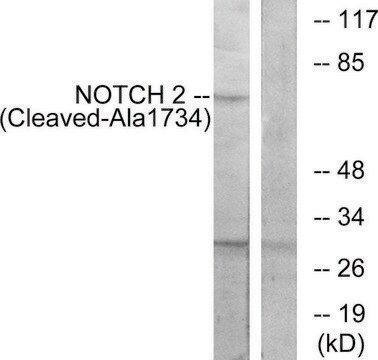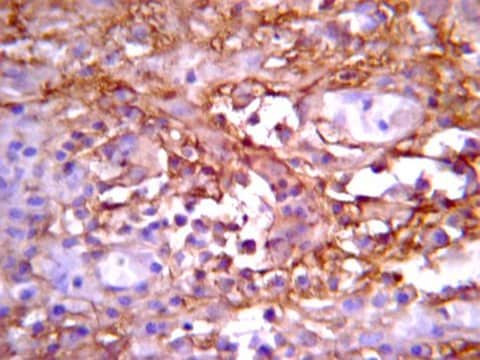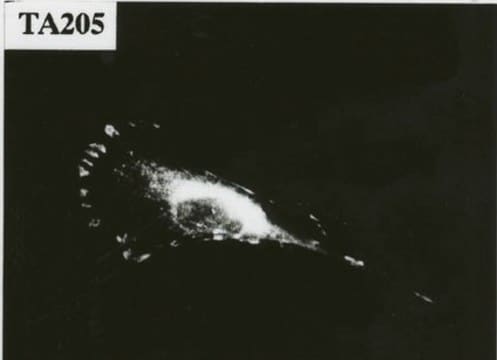07-1234
Anti-Notch 2 Antibody, NT
serum, from rabbit
Sinonimo/i:
Neurogenic locus notch homolog protein 2 precursor, Notch (Drosophila) homolog, Notch 2, Notch homolog 2 (Drosophila)
About This Item
Prodotti consigliati
Origine biologica
rabbit
Livello qualitativo
Forma dell’anticorpo
serum
Tipo di anticorpo
primary antibodies
Clone
polyclonal
Reattività contro le specie
mouse, human
Reattività contro le specie (prevista in base all’omologia)
rat (14/15 immuongen sequence homology)
tecniche
ELISA: suitable
immunohistochemistry: suitable (paraffin)
western blot: suitable
Isotipo
IgG
N° accesso NCBI
N° accesso UniProt
Condizioni di spedizione
wet ice
Informazioni sul gene
human ... NOTCH2(4853)
Descrizione generale
Specificità
Immunogeno
Applicazioni
1:30,000-1:90,000 dilution from a previous lot was used in a standard sandwich ELISA assay against the peptide immunogen.
Optimal working dilutions must be determined by the end user.
Immunohistochemistry(paraffin):
Representative testing from a previous lot.
Optimal Staining of NOTCH-2 Polyclonal Antibody: Squamous Cell Carcinoma
Epigenetics & Nuclear Function
Transcription Factors
Qualità
Western Blot Analysis: 1:500 dilution of this lot detected cleaved NOTCH2 on 10 μg of NIH/3T3 lysates.
Descrizione del bersaglio
Linkage
Stato fisico
Stoccaggio e stabilità
Handling Recommendations: Upon first thaw, and prior to removing the cap, centrifuge the vial and gently mix the solution. Aliquot into microcentrifuge tubes and store at -20°C. Avoid repeated freeze/thaw cycles, which may damage IgG and affect product performance.
Risultati analitici
NIH/3T3 Cell Lysate
Esclusione di responsabilità
Not finding the right product?
Try our Motore di ricerca dei prodotti.
Raccomandato
Codice della classe di stoccaggio
12 - Non Combustible Liquids
Classe di pericolosità dell'acqua (WGK)
WGK 2
Punto d’infiammabilità (°F)
Not applicable
Punto d’infiammabilità (°C)
Not applicable
Certificati d'analisi (COA)
Cerca il Certificati d'analisi (COA) digitando il numero di lotto/batch corrispondente. I numeri di lotto o di batch sono stampati sull'etichetta dei prodotti dopo la parola ‘Lotto’ o ‘Batch’.
Possiedi già questo prodotto?
I documenti relativi ai prodotti acquistati recentemente sono disponibili nell’Archivio dei documenti.
Il team dei nostri ricercatori vanta grande esperienza in tutte le aree della ricerca quali Life Science, scienza dei materiali, sintesi chimica, cromatografia, discipline analitiche, ecc..
Contatta l'Assistenza Tecnica.








